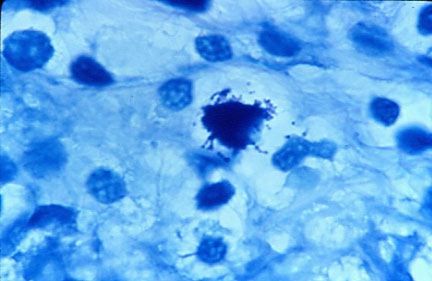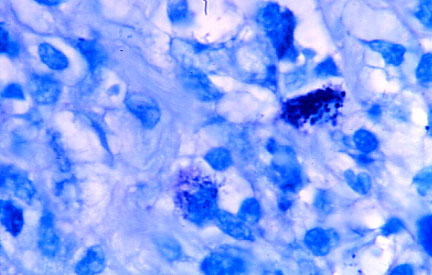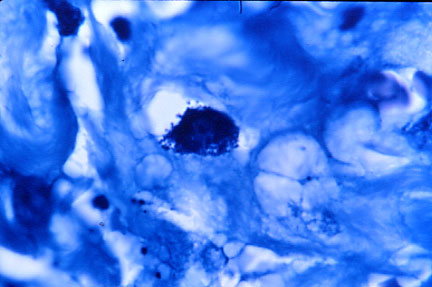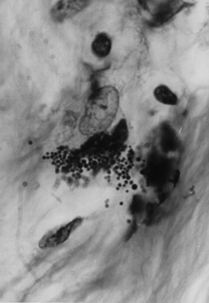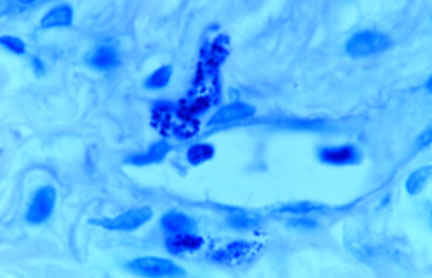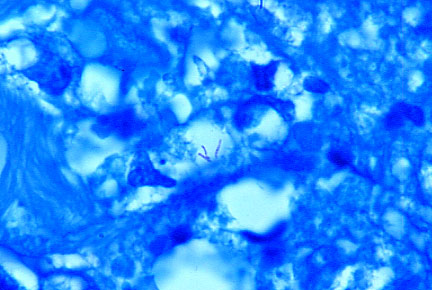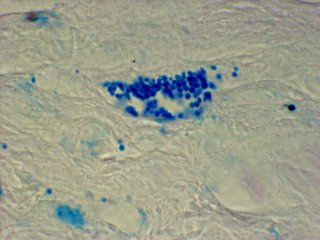|
|
|
from Rense Website
TB-type bacteria can be seen in specially-stained tissue sections of cancer tumors and viewed under the highest magnification of the light microscope at a magnification of 1000 times, under oil immersion.
So why isn't this simple
microscopic procedure performed in cancer?
Yet, a century ago, the powers-that-be in medical science ignored this research and declared emphatically that bacteria were not the cause of cancer.
The reasoning behind
this dictum was that cancer did not act like an infectious disease,
nor was it communicable. We know now this reasoning was false. Many
scientists believe viruses cause cancer; and sexually- transmitted
cancer-causing viruses can be passed from person-to-person as well.
Virginia Livingston M.D. (1906-1990) was the foremost proponent of the bacterial cause of cancer. She was the first to discover that the acid-fast stain was the key to the detection of the cancer germ, both in tissue (in vivo) and in laboratory culture (in vitro).
Livingston, along with microbiologist Eleanor Alexander- Jackson, cell cytologist Irene Diller, and chemist and TB expert Florence Seibert, all reported that the cancer germ was pleomorphic (meaning it has various appearing growth forms) and was filterable, indicating that in certain stages of its life cycle the microbe was virus-like and submicroscopic.
Bacteria can be seen
with the light microscope; the much smaller viruses cannot. (For
more information on the
acid-fast stain,
mycobacteria, and
pleomorphism, simply Google those
key words.)
Cancer microbes in vivo are primarily in the cell-wall-deficient (CWD) form. As a result of the loss of a cell wall, the bacteria appear as round, coccus-like, granular forms that are found both within the cell (intracellular) and outside the cell (extracellular). Various types of bacteria may all look similar when in the CWD form.
In the body and in the laboratory CWD bacteria (also known as "mycoplasma") have the amazing capacity to enlarge in size.
These so-called round
"large bodies" can attain the size of red blood cells and even
larger. When seen in cancerous tissue these large bodies of bacteria
can resemble large spore forms of yeasts and fungi, perhaps
explaining why some researchers claim Candida and other fungi are
the cause of cancer.
Pathologists generally believe these large forms are "immunoglobulins" and they do not accept them as microbial in origin. It is my contention that Russell bodies represent large, variably-sized CWD forms of bacteria in vivo; and that is why both coccal forms of CWD bacteria, as well as Russell bodies, can both be identified in cancerous tissue.
Note:
For more details and microphotographs, see my paper "The
Russell body: The forgotten clue to the bacterial cause of cancer,"
and view my video lecture "The
cancer microbe and the Russell body".
As mentioned, bacteria were excluded a century ago, and medical science never looked back. The result was that any physician who persisted in cancer microbe research was never taken seriously and was often viewed as a medical pariah. There are less than a handful of living physicians in the world who actively promote cancer microbe research.
Erik Enby is a 70 year-old Swedish physician, whose accomplishments are cited in the Wikipedia. Nevertheless, his medical license has recently been revoked by the government for his belief in cancer-causing bacteria.
I am currently regarded
by the Wikipedia as a "conspiracy theorist in the field of cancer
microbiology."
Over the past decade British microbiologist Milton Wainwright has written extensively about the history of the cancer microbe and his reports are easily accessible on the Net.
In Current Trends in Microbiology in 2006, he wrote:
In retrospect, it was premature and irrational a century ago to discard bacteria in cancer because the science of bacteriology was in its infancy.
Nothing was known about CWD forms and filterable virus-like forms of bacteria. The recent acceptance (after a century) of bacteria (Helicobacter pylori) as the cause of most stomach ulcers is a case in point.
For several decades after his 1940 discovery of peculiar S-shaped bacteria in stomach ulcers, A. Stone Freedberg MD stood alone.
His research was totally ignored because doctors believed that bacteria could not exist in the acid environment of the stomach. A half century later, these same bacteria were finally accepted and are now a major factor in the development of stomach cancer. Two Australian scientists (Barry Marshall and Robin Warren) received a Nobel Prize in Medicine in 2005 for proving this.
Interestingly, in 1998,
a new tumor-like stomach lesion was discovered called "Russell body
gastritis."
In TB the microscopic appearance of the typical red- staining "acid-fast" rod-shaped bacillus of M. tuberculosis is well-known.
However, the pleomorphic CWD forms of M. tuberculosis and mycobacteria look entirely different from the typical rod form. CWD forms in vivo appear primarily as small, round coccal and granular forms. They stain poorly, if at all, with the time-honored Gram stain for bacteria. In addition, the routine stain (hematoxylin-eosin stain) used by pathologists to diagnose cancer is not suitable to demonstrate CWD bacteria.
To demonstrate the
typical red-staining rods of M. tuberculosis, an "acid-fast" stain
in required.
Examples of the microscopic appearance of intra- and extracellular cancer microbes in acid-fast stained tissue sections (viewed at a magnification of 1000 times, in oil) are shown in,
...in Figures 1-7 below.
Note that the microscopic appearance of CWD bacteria in vivo appears similar in various types of cancer, and consists primarily of small coccoid forms, resembling the size and shape of ordinary staphylococci.
Fig 1 Tissue section of breast cancer showing (in center) tightly-packed
intracellular coccoid
forms with some forms loosely attached to the cell.
Additional view of breast cancer showing two areas (one below center and the other on the right) of intracellular coccoid forms.
Tissue section of lung cancer showing tightly-packed intracellular coccoid forms.
Tissue section of Hodgkin's disease showing intracellular and
extracellular coccoid
forms in the connective tissue at autopsy
Tissue section of fatal AIDS-related Kaposi's sarcoma of the skin showing two foci of coccoid forms
Tissue section of fatal case of AIDS-related immunoblastic sarcoma of the face. Three red-stained typical acid- fast rods are seen in the center. These forms are extremely rare in cancer. Mycobacterium avium-intracellulare was cultured from the tumor
Tissue section from prostate cancer showing a focus of closely-knit coccoid forms as well as scattered forms.
Further complicating the bacteriology of cancer is the observation that similar-appearing microbes can be seen in vivo in certain chronic diseases, such as lupus, scleroderma, sarcoidosis, and others.
Livingston claimed that all human beings carried cancer microbes; and she postulated these microbes were closely connected with the origin of life. In the healthy state these microbes caused no harm and were beneficial. However, when the immune system was weakened, these bacteria were capable of inducing a variety of human illnesses, including cancer.
CWD bacteria may prove
to be the cause of many illnesses currently regarded as "of unknown
etiology." Because submicroscopic forms of CWD bacteria are
virus-sized, they may be confused with ordinary viruses. CWD
bacteria are also resistant to antibiotics and are difficult (if not
impossible) to eradicate or subdue, at least in the current state of
our knowledge.
Although bacteria can be identified in cancer, there are obviously other well-known factors that can induce cancer, such as sunlight in skin cancer, smoking in lung cancer, radiation-induced cancer, etc. But in each case it may require these ever-present bacteria to induce the cellular changes of cancer.
The demonstration that these microbes are found within the cell and even within the nucleus (as shown by Irene Diller) indicates that these agents may access the genetic material of the cell, thereby transforming the cell to a cancerous state. In this respect, CWD forms may act like viruses.
Studies by Douglas
Robinson MD show that bacteria (like viruses) may swap genes
back and forth between the infected cell and the microbe.
In my view, Virginia Livingston's greatest contribution was her observation that the microbe could be detected in all cancers in vivo with an acid-fast stain.
Only when physicians
learn to recognize and accept these
infectious bacteria in cancer can we begin to design appropriate
therapies against them.
|


